


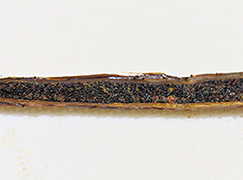
Vanilla beans from Madagascar
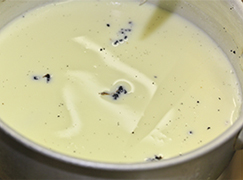
Adding the vanilla beans and pods
to the milk
to the milk
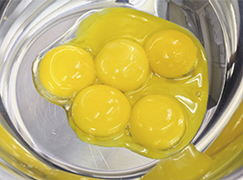
The soft lemon yellow eggs
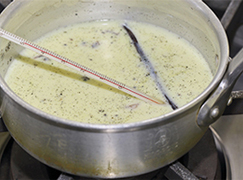
Vanilla-infused milk is warmed to
body temperature
body temperature
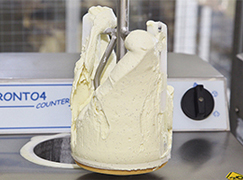
When it’s made, our ice cream comes out
like a rich soft cream.
like a rich soft cream.
There are many vanilla ice creams but
they all taste different. MIHO MUSEUM’s vanilla ice cream, for
some reason, tastes like sunshine. It’s both refreshing and
rich; each bite is a mouth full of vanilla-flavored happiness.
The key ingredient is naturally farmed vanilla from Madagascar
and naturally farmed milk and eggs. Madagascar is an island
nation that is slightly larger than Japan in east of Africa.
Over 70% of the world’s vanilla is produced there. Vanilla
flowers bloom in the morning and fall at night so they must be
pollinated that day for the vanilla beans to grow. The harvest
of 800 hand-pollinated flowers per day is packed into our ice
cream. The scent of vanilla rises from the pod as soon as it is
cut open with a knife. Inside, tiny seeds are packed tightly.
Our cooks immediately place the vanilla beans and pod into the
milk to capture as much of the vanilla’s scent as possible.
The milk that goes into our ice cream
comes from a farm in Kumamoto that raises Jersey cows that are
fed only all natural grass. Thirty cows leisurely live on an
area of land that is three times the size of the Tokyo Dome, if
the mountaintop were cut off. The milk from cows that are
carefully raised without chemicals is sweet, rich, and
flavorful. According to the milk farmers, grass-fed cows produce
milk that has unsaturated fats that dissolve quickly and are
good for the body. Although it has a creamy yellow color, this
milk is smooth and completely unlike any milk you find in
stores. But each time it’s delivered, a surprising
transformation in its flavor occurs. Our cooks are impressed
every time by its deep sweetness, strong scent, richness, and
smoothness as they make our original ice cream.
Meanwhile, the eggs come from
specially raised chickens that primarily eat naturally farmed
rice-bran and rice that are mixed with finely cut grass and
oyster shells as feed. The chickens do not eat any commercial
feed or chemicals, and they live in a spacious area. Their light
lemon yellow-colored eggs are soft and incredibly delicious.
According to a recipe book, to make
ice cream, you must warm vanilla-infused milk to body
temperature, mix in egg yolks, sugar, and cream that have been
heated, and continue heating until the mixture thickens. But our
ingredients do not thicken for some reason. When the cows and
chicken live happily, something different happens. If the mixing
temperature is raised above 65 degrees, the ice cream becomes
grainy, and if the ingredients are poured into an ice cream
maker that is too cold, its texture crumbles. Our kitchen makes
soy ice cream, chocolate ice cream, and occasionally hōjicha
(roasted green tea) ice cream but we’re this sensitive only with
our vanilla ice cream. We make it carefully almost as if
handling a baby.
Now, when we
take out our ice cream, it’s like a thick soft cream. The blade
of the ice cream maker is thickly covered with butterfat. Our
cooks smiling say, “Only those who make it can taste test it.”
The flavor is so delicious! The scent of vanilla that has been
sun-drenched in Madagascar and the creamy flavor of milk leave a
sweetness that melts away in your mouth. Occasionally, granules
of milk fat appear, then quickly disappear as it adds an accent
to the flavor. But the ice cream changes flavor ever so slightly
each time you eat it. The first time, it’s like a nostalgic
sunny spot from the distant past. The second, the flavor becomes
delicate and smooth, making you feel like swinging on a lace
hammock in a refreshing shade. Perhaps it’s the milk. The flavor
of seasonal foods should change with the season, each tasting
delicious in their own right. We hope you try our ice cream with
a crunchy tuile!